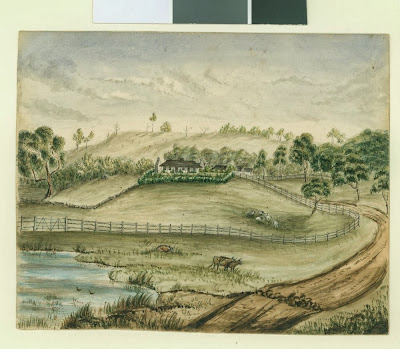The von Stieglitz family of Tasmania and Victoria were descended from Christian Ludwig von Stieglitz who was created Baron of the Holy Roman Empire in 1765. The second baron - Heinrich Ludwig - son of Christian emigrated from Bavaria to Ireland with his family around the turn of the 18th century. However, following the death of the second baron in 1824, his wife, six sons and three daughters found themselves in straitened circumstances, consequently each of the six grandsons at one time or another sought their fortune in Australia. Biographical details for each can be found in the Australian Dictionary of Biography.
Of particular relevance to the Moorabool Valley are the three brothers - Robert William, John Lewis and the youngest - Charles Augustus. Robert along with his brothers Frederick and Francis arrived in Tasmania in 1829, with the others following in subsequent years. Unlike their brothers, John and Robert did not receive land grants in Tasmania but instead crossed Bass Strait with the earliest squatters to take up land in the Port Phillip district.
On 9th November, 1835, John von Stieglitz along with John Anthony Cowie and David Vere Stead were amongst the first settlers lead by John Batman to land stock at Port Phillip. They arrived from Tasmania on the ship Norval, landing at Gellibrand's Point (Williamstown).
von Stieglitz, Cowie and Stead were quick to head west in search of pasturage for their stock. In March, 1836, Cowie and Stead - I assume with the von Stieglitz's - took up a run at what is now the suburb of Bell Post Hill in Geelong, holding the land which ran down to the Moorabool River (see Branching out - from squatting to schooling).
About two months later on 3rd May, John von Stieglitz married John Cowie's sister Emma at her brother Robert's home in Tasmania. Soon after on the 9th July, he arrived at Point Henry with more stock for their run.
By 1838 - already finding the rapid increase in population occurring with the settlement of the town of Geelong too restrictive - the brothers, along with Cowie and Stead moved their stock on to greener pastures further up the Moorabool River. Robert settled his sheep on 4,836 acres which he called Ballan (named for a town in Ireland) near the head of the eastern branch of the Moorabool River.
 |
| Ballan House, drawn by Emma von Stieglitz (nee Cowie). Image held by the State Library of Victoria |
 |
| Ballanee, drawn by Emma von Stieglitz, Image held by the State Library of Tasmania |
The third of the von Stieglitz brothers to take up a run on the Moorabool was the youngest son, Charles Augustus. He arrived in Victoria in 1839, having stayed behind in Ireland to complete his schooling. Prior to his arrival, and the same year in which they were establishing the original Bell Post Hill run near Geelong, Cowie and Stead also took up a lease of 8,000 acres further up the Moorabool on its eastern bank. This land lay between what would become the Moranghurk run of William Taylor and Dugald McPherson to the south and John Norman McLeod's Borhoneyghurk to the north. They called the run Durdidwarrah a Wathaurong word which I have seen described as meaning either "shelter of bark" or "dead water".
In 1842, Durdidwarrah - now extending to 24,000 acres - was passed to Charles von Stieglitz who established himself there, extending the run to eventually include 74,000 acres. During the 1840s, a simple residence was erected on the property followed in 1849 by a larger brick house with Georgian and Edwardian features. Both still stand today, the former as an outbuilding and the latter with alterations and additions made over the years.
 |
| Original building at Darra, 1962. Image from the J.T. Collins Collection, La Trobe Picture Collection, State Library of Victoria |
In 1863 Durdidwarrah was purchased by William Thomas Napier Champ, the first premier of Tasmania, who changed the name of the property to Darra. Champ had also served as the Commandant of Port Arthur and arrived in Victoria in 1857 to take up the role of Inspector-General of Penal Establishments. Throughout his career in the justice system he was seen as a fair and humane figure. He retired from his public role in 1868 to Darra where he spent the remainder of his life developing the property, pursuing pastoral pursuits and playing a role in the local community. In addition to the 200 acre pre-emptive right purchased by Charles von Stieglitz in 1853, Champ added a further 1075 acres, most of it purchased in 1867 and then another 300+ acres in 1884. He died in East Melbourne in 1892.
 |
| Darra homestead, 1962. Image from the J.T. Collins Collection, La Trobe Picture Collection, State Library of Victoria. |
Such setbacks notwithstanding, Darra remained in family hands until January, 1922 when, due to advancing age, Mr JW Champ sold the property, consisting of around 2,000 acres with all stock and plant.
By the 1930s Darra was in the hands of the prominent Austin family, many of whom owned properties in the region.
Whilst the Durdidwarrah/Darra Estate saw the usual pattern of squatting and grazing, followed by selection and closer settlement, geological circumstance meant that the development of a part of this run was unlike any other in the region. It has been said that whilst he was digging a well, Charles von Stieglitz discovered a rich gold reef. He immediately had the well filled in and nothing further was mentioned. However, in 1855 everything changed...
No comments:
Post a Comment